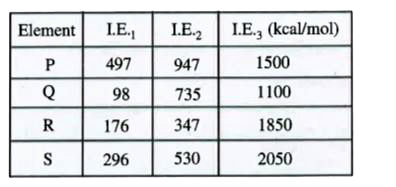Why a large amount of energy is needed to remove an electron from a neutral gaseous neon atom than the energy needed to remove an electron from gaseous sodium atom?Solution in Telugu
Step by step video & image solution for Why a large amount of energy is needed to remove an electron from a neutral gaseous neon atom than the energy needed to remove an electron from gaseous sodium atom? by Chemistry experts to help you in doubts & scoring excellent marks in Class 10 exams.
Updated on:21/07/2023Topper's Solved these Questions
Similar Questions
What are the general molecular formulae of alkanes, alkenes and alkynes?
View SolutionSoaps do not create water pollution because _____
View SolutionIf Ee is the energy needed to remove an electron from atom and En be energy needed remove a nucleion, then:
View Solution29 electron are remove from Zn atom (Z=30) by certain means . The minimum energy needed to remove the 30th electron , will be :
View Solution29 electrons are removed from Zn-atom (Z=30)by certain means. The minimum energy needed to remove the 30th electron, will be
View SolutionThe removal of an electron from which gaseous atom requires the greatest amount of energy?
View Solutionएक उदासीन हीलियम परमाणु से एक इलेक्ट्रॉन को हटाने के लिए आवश्यक ऊर्जा 24.6 eV है। उदासीन हीलियम परमाणु से दोनों इलेक्ट्रॉनों को हटाने के लिए आवश्यक ऊर्जा (eV) में है
View SolutionThe energy that is needed to remove an electron from the 1st Bohr orbit or Hydrogen atom is
View SolutionIonization potential is the minimum amount of energy needed to remove the outermost electron from the gaseous isolated atom. Its unit is eV/atom or kJ/mol. Successive ionization energy is the amount of energy needed to remove electron successively from a gaseous ion, it may be termed as I.E._2, I.E._3 , .... The difference in the values of I.E._1, I.E._2 , . helps to determine electronic configuration of the elements. Which of the element can make MX type compound (X is the halogen)?
View SolutionIonization potential is the minimum amount of energy needed to remove the outermost electron from the gaseous isolated atom. Its unit is eV/atom or kJ/mol. Successive ionization energy is the amount of energy needed to remove electron successively from a gaseous ion, it may be termed as I.E.2,I.E.3, .... The difference in the values of I.E.1,I.E.2, . helps to determine electronic configuration of the elements.

The order of ionic mobility in aqueous solution of the following ions will be (If R, S belong to same group):
View SolutionIf electron is removed from an atom then is energy
View SolutionThe minimum amount of energy required to remove the most loosely bound electron from an isolated, neutral gaseous atom is known as ................. (I.E/E.A).
View SolutionFill in the blank from the choices given in brackets :
The energy required to remove an electron from a neutral isolated gaseous atom and convert it into a positively charged gaseous ion is called ............ (electron affinity, ionisation potential, electronegativity)
View SolutionWhy a large amount of energy is needed to remove an electron from a neutral gaseous neon atom than the energy needed to remove an electron from gaseous sodium atom?
View SolutionThe minimum energy required to make positive ions by removing electrons from a gaseous neutral atom is .......
View SolutionAn energy of 24.6 eV is required to remove one of the electrons from the neutral helium atom. The energy (in electron volts) required to remove both the electrons from a neutral helium atom is
View Solution
